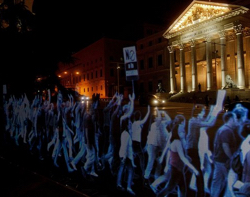hologram
 a.k.a. virtual demonstration, holographic technology
a.k.a. virtual demonstration, holographic technology A 3-D image formed by light beams from a laser or other coherent light source. It is a photographic recording of a light field, rather than of an image formed by a lens, and when suitably illuminated, produces a three-dimensional image.
Historical perspective: In 2015 Spain passed a law that would fine protesters up to $635,000 if they gather outside legislative buildings or power plants, and around $600 for "disrespecting" a police officer. So the people turned out for a hologram protest. Since they're not allowed to gather in the flesh, Spanish activists organized a virtual demonstration and called on supporters to create holograms of themselves using a webcam and specialized software. More than 18,000 people did so and the results were displayed on a screen in front of the parliament building: a ghostly assemblage denouncing the People's Party.
By 2016, media companies HBO and Discovery Communications invested in OTOY, a tech company that specializes in holographic technology, believing that holograms could be the future of entertainment. The ultimate aim is to allow people to see lifelike content in their living rooms without the need for extra equipment, like a virtual reality headset or computer. For example, users might one day be able to pull up the HBO website on a smartphone and project a holograph of the content on to their coffee table, so that eventually the screen itself goes away.


Edit Word